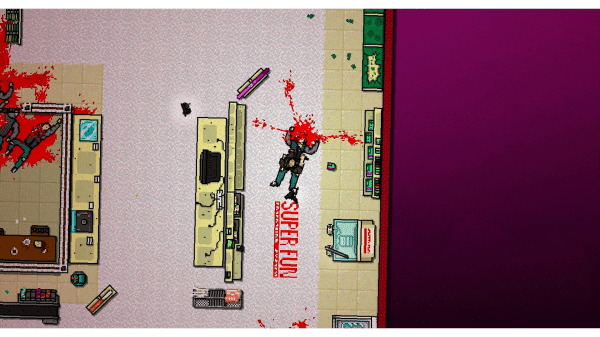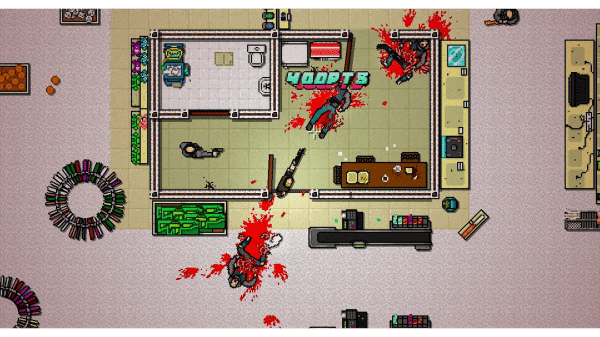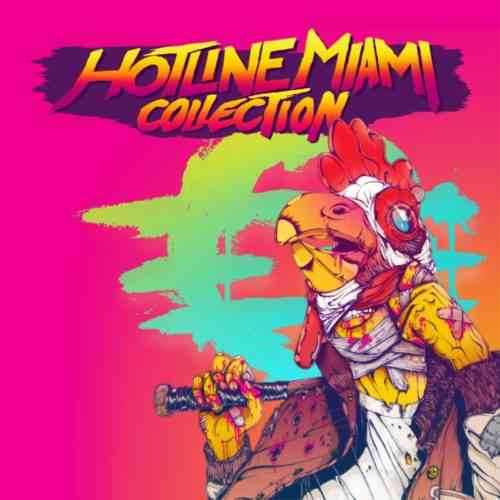Hotline Miami Collection Review
While Hotline Miami initially released in 2012 for PC, the console community has been left high and dry until recently and the two games are a great addition to any platform’s lineup. The top-down stealth games that are full of gore seamlessly transition to consoles for better and worse, making it equally as playable. Any hiccups I encountered in these games on console can be contrasted by the same issues on PC, such as the inability to see characters off-screen or the required split-second reaction times when taking on armed enemies. These games are essential for both fans of the shoot ’em up genre and the stealth genre as they’re equally competent in both regards. While you may have nightmares and an increased heart rate after playing these games, you’ll need to play that one more time to get over a specific level that you’ve been stuck on, making them two of the most addicting indie games I’ve ever played.
The first game features a somewhat incoherent storyline, sparking several fan attempts at making sense of the very bizarre events of the game. The protagonist awakens to a phone call that’s rather vague, with ambient EDM that sounds like it’s being played under water in the primary hub, the apartment. These phone calls are the primary quest giver of Hotline Miami and each call seems to be from different clients who are interested in your service: effective murder. While the extremely trippy music starts any given day in Hotline Miami, the completion of a mission features very chill techno, making it seem like the protagonist finds tranquility in what he does and goes home with a smile on his face at the end of a day. Although this game is branded as a top-down shoot ’em up, there are significant stealth elements, requiring you to hide from patrolling enemies. These range from the average goon dressed in blue and white to massive dudes who can absorb tons of damage and dogs who will hunt you to the ends of the Earth. Dogs will even go as far as to chase you outside the level you’re searching and around the whole building if you can evade them. While there are various masks you can wear for each mission, they don’t seem to play as much of a role in Hotline Miami as they do in Hotline Miami 2: Wrong Number. While the masks play a big role in both games, the second title makes it essential to know which mask is best for which level, whereas the first game felt more randomized, allowing you to complete missions with any masks.

Luck Can Make or Break You From One Stage to Another
Both games feature fantastic soundtracks and bright neon colours contrasted by the dark 1980’s criminal underworld. Both the art and sound direction of these games are flawless and it’s clear that developers at Dennaton Games knew this when they worked on Hotline Miami 2: Wrong Number, maintaining both the sound, music and art quality. While there are many disturbing moments in the games, things sound almost too realistic in some cases and I could listen to the soundtrack on its own like the best OST’s out there. While the first game offered an ambiguous narrative that allowed gamers to piece together story bits to create their own overall narrative, the second title includes a more specific and coherant plot that is told effectively. The top-down perspective of the game makes some deaths unavoidable, being unable to see enemies who are too far away but because they’re down a hallway, they can shoot you. In some cases they can even shoot you before you see them. To mitigate this problem, console players can target nearby enemies on Hotline Miami and look around with the push of a trigger in Hotline Miami 2: Wrong Number. This definitely minimizes potential problems but I noticed some issues with swapping from targeting an enemy to moving the cursor on my own using the right stick. It’s somewhat clunky and I wish that it just automatically took my focus off an enemy as soon as I move the stick. There are some frustrating moments that wouldn’t be as noticeable on PC because of the clunkier controls of a console. While the Xbox controller is definitely the ideal one to use while playing these titles, it still has drawbacks. One example of this is when using doors to kite enemies to you or attacking in any way near a door. Doors are less predictable than the randomly generated weapons laying around each level as sometimes they’ll take down an enemy as you’d expect and other times it opens slightly less than that other time and it ruins your entire game plan. Shooting near a door can be bad as well, with the door absorbing all damage without moving if you’re aiming in the general direction. Because of the random nature of both games, this isn’t such an issue but enemies can definitely use doors to their advantage as much as you can. One door can make or break your kill combo so use them wisely.
Neon Colours, Distorted Visuals and Animal Masks Will Haunt Your Dreams
Some levels will frustrate the hell out of you and others will surprise you, following a significantly difficult level with a fairly basic one. A significant aspect of the gameplay requires luck and in some cases you’ll be screwed if a melee weapon doesn’t spawn in a specific room. My most nail biting, sweaty experiences were felt when luck was against me but I still succeeded, using an empty pistol as a throwing weapon to take a baseball bat to smack another enemy with to take their shotgun and following these murders with three successful shotgun blasts through a doorway through the chests of multiple gangsters. While you can get the job done using your fists, the second you encounter a dog is the end of your dream of completing an unarmed playthrough of Hotline Miami. Due to the randomized loot, your gameplay experience changes for each death similar to a rogue like, but Hotline Miami is much more forgiving in the sense that if you’re skilled enough with the gameplay, you can turn bad luck into good luck. If you’re feeling any sympathy for the fictional enemies, you may find solace in the fact that levels include them doing things such as torture. The stage design of each level varies, but only slightly in the first title. Levels range from bumping discos to multiple floor structures that involve ledge scaling to a restaurant full of armed waiters and waitresses. Although the variety isn’t felt much from room to room, it’s noticeable if you walk around the level and take it all in as one stage. Both titles include seemingly limitless bloodshed but I only really felt the impact of my actions in the second title with how all over the place the plot of the first title is.

Hotline Miami Collection, Quentin Tarantino’s Feverish Nightmare
Hotline Miami 2: Wrong Number includes a level editor, allowing fans to create their ideal Hotline Miami experience, making this title endlessly replayable. While this hasn’t been as established on consoles as it has on PC, it’ll only be a matter of time before console Hotline Miami fans are making impossible levels that make the hardest campaign level blush. Hotline Miami 2: Wrong Number is the definition of a sequel, bringing more of the same to fans of the original without changing the structure too much. The only thing beyond the plot that I noticed had changed was the difficulty, but if you play through the first game completely, the second one won’t be intimidating. I definitely don’t recommend charging into the second title without playing the first one though. Hotline Miami 2: Wrong Number is all about bringing more to the table; more enemies, more weapons, more masks, more stage clutter, etc. Typically, I’ll complain about a developer not changing enough from one title to another but as such a big fan of the first Hotline Miami, I didn’t mind it too much. Both titles being bundled together makes it feel like one big game that just improves from one half to the other.
While I encountered the odd glitch from time to time in Hotline Miami, none were too intrusive. I noticed a bug that I could reliably recreate that booted me out of my game when I paused it just after hanging up the phone to receive a mission. This happened several times but most were intentional, making sure I wasn’t pressing a wrong button and that my controller buttons weren’t sticky. The graphics of Hotline Miami and Hotline Miami 2: Wrong Number may not impress anyone but they’re the best low-rez stealth-based games I’ve ever played. I’d say that both games are not only my favorite Dennaton Games titles but also my favorite Devolver Digital published games. The hitman bloodshed is savage but because of the low-rez visuals, blood is even less traumatizing than the original Mortal Kombat games. These titles felt risky to create initially but to me, that risk paid off. These are essential games to anyone looking to build up an indie collection and I recommend them to any stealth or shoot ’em up fans. The soundtrack and neon visuals alone are worth checking these games out for but if you enjoy weird plots, Quentin Tarantino films or the 1980’s, I also recommend this collection. There’s a lot of fun to be had across both titles if you have the patients. Some moments will feel like beating your head against the wall and others will feel like that small crack that brings a dam crumbling down. The difference between a successful run and a failure is clutch timing and a bit of luck. Bloodshed has never looked so good top-down.
***Xbox code provided by publisher***
The Good
- EDM soundtrack
- Quality top-down stealth
- Sound and art design
- 1980’s gore
- Distinct stages
The Bad
- Luck plays significant factor
- Precision timing required

